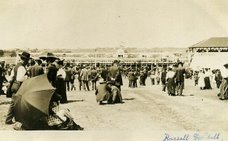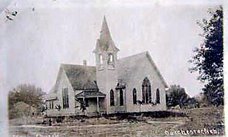 We have received notification on Facebook that the Saline County Museum will open for the season this Sunday, April 3. All individuals and families are strongly encouraged to visit and get in touch with this area's unique and special history.
We have received notification on Facebook that the Saline County Museum will open for the season this Sunday, April 3. All individuals and families are strongly encouraged to visit and get in touch with this area's unique and special history.
For those who don't know, the museum's roots can be traced back to the 1950's, when Dorchester's own Rosa Dusanek had a dream of building a Saline County museum to house the history of our area's people.
By 1957, the Saline County Historical Society was established. In 1960, the Saline County commissioners gave the society a one-tenth mill levy.
The Chapel contains “In Loving Memory” funeral displays, an altar and wedding dresses and suits. A nearby memorial pays tribute to Dorchester's Charlie Havat, the last American killed in WWII's European Theater.
The Memorial Building has an 1800’s bedroom, a parlor and a kitchen. There is a textile room, dentist office, doctor’s office and a beauty shop.
There is a section for all organizations of Saline County. The Museum will take organizational minutes and scrapbooks from disbanded organizations.

The Weidner Building which houses the fire truck, wagons, photography, and electrical displays.
The Machinery Building has implements from the past centuries.
The Voting Building is original. This building was only used for voting.
The Buckingham School is a one room country school from 1871. It is a building where present day children can go to school to see how their great grandparents were educated.
The Burden Home belonged to the first black homesteader in Saline County. Seven children were born and raised in this two room home, dated 1868.
The Cizek log cabin, which dates back to 1866, is in the yellow building, along with a large collection of barbed wire and other items.
The Dorchester Depot Building houses fascinating railroad memorabilia.
And the Plato Post Office building is a traveling post office -- a tiny building that moved from farm to farm.
The Saline County Museum is operated strictly by volunteers. The Saline County Historical Society Board consists of ten individuals who meet quarterly.
There is no admission fee, although donations are welcome.
The Saline County Museum is now open for the season -- Sunday afternoons from 2-5 p.m.
Judy - (402) 243-2356
Mary Anne - (402) 448-5265
The museum volunteers tell the Times that they are working on new displays. If you haven't been to the museum in a few years, you really need to stop by and seen the many changes.


















































You read my mind! Thanks so much for doing this story. Ironically, I am a fourth-generation Saline County native and have never toured the museum. However, I will be home the weekend of June 22 and plan to make my first visit. By the way, I spoke on the phone with a very nice volunteer at the Dorchester Library who gave me contact information for the museum. The woman at the library said that many residents were unaware that a library even existed. This might make a nice feature story.
ReplyDeleteSo where in the world, or the county, was Plato?
ReplyDeleteIf our collective memory is correct, Plato -- which consisted only of a post office -- was located between Dorchester and Tobias.
ReplyDeleteThe post office opened in 1884 and was discontinued in late 1900, according the USGS.
I'm glad to see that the Dorchester Times also likes David McCullough. His "Truman" book was great! Presidential historian Michael Beschloss was in Nebraska last fall for a speaking engagement. He is also very engaging. By the way, neither author has advanced degrees in history.
ReplyDeleteI found this extract from an 1895 Nebraska Map. Not very good, but it does show the location of Plato.
ReplyDeletehttp://www.livgenmi.com/1895/NE/County/saline.htm
My grandmother, Libby "Wanek" Stirba was born in the log cabin at the museum. No one knew it was a log cabin until many years later, when it was about to be torn down. My grandpa Joe, used to joke that had he known grandma was born in a log cabin, he would not have married her. Grandma's parents were Josef and Mary "Pasek" Wanek. Josef was about seven when his parents, Antonin and Eva Wanek, came to the United States and settled along the banks of the Blue River in what is now Wilber in 1870.
ReplyDeleteI love history, and geneology. Saline County is lucky to have the Museum, and the people dedicated to it. Dorchester is very fortunate to have the museum situated where it is! Well worth the visit!
JR Wolfe
My favorite display is still the old railroad depot. How great would it be to meet fellow Dorchester residents and ride the train to Lincoln or Omaha for a day away?
ReplyDeleteJR,
ReplyDeleteI knew Joe and Libby. I also know your cousins. (Tyser family) Thanks for all the interesting information you bring to this blog. Speaking of trains, my 69- year-old mother said she and my grandmother would travel by train to Lincoln in the 40's and 50's. (My grandmother did not drive.) She also said the first and only time she ever saw an African-American was during those train rides. Apparently, African-American men served as porters in those days.
I rode the train many times between Lincoln and Dorchester, also between Denver and Dorchester during my college years (in the 50's). At the time, it seemed like the way to travel, now it seems so "old fashioned" in the wake of planes and cars. Wouldn't it be great to go back in time for one day and take a train ride to Lincoln?
ReplyDeleteA lot of them traveled by trains even short distances. My great great grandfather Frank Plachy rode the train a lot from Shestak's (between Crete and Wilber) to Wilber. The Plachy homestead wasn't far from Shestak's, he would walk to there and catch the train.
DeleteTo Anonymous-June 19, 2008 1:08 PM
ReplyDeleteThanks for the additional information on riding the train from Saline County in the 50's. Compared to my mother, you sound adventurous as you rode to Denver! However, one summer she did venture to the Deep South for summer school in the late 50's. I'll ask if she took the train. The older trains probably offered much better service compared to Amtrak. When I lived in Pennsylvania, I noticed that many towns converted their former train depots into bars and restaurants.
Holdrege has done an amazing job restoring their old depot into a small business plaza.
ReplyDeleteI recently toured the museum for the first time and it was well worth the visit. I knew many of the people mentioned in the exhibits and even saw a replica of what could have passed as my great-grandparent's living room! I also viewed artifacts from businesses owned by my ancestors in the early 1900's. I would encourage everyone to visit and "support" the facility.
ReplyDeleteI believe the one room school house used to be called the Buckingham School which my grandfather attended. Dorchester elementary students used to go to the museum each spring when they had their picnic day. The class of 1976 had pictures for the yearbook taken there.
ReplyDeleteI believe you are correct that the school was named Buckingham
DeleteDorchester can be very proud of that museum. And proud of the volunteers who work there.
ReplyDeleteAwesome history!
ReplyDeleteEveryone needs to go visit after it opens again the end of April because the Dorchester Art classes painted a very neat mural in the new building!
ReplyDeleteThe museum opened for the summer April 13. Spring Open House is April 27 with a musical program at 2p.m. we have new exhibits and look forward to a busy season. We can always use help with work at the museum. If you are interested in helping contact us. 402-243-2356.
ReplyDeleteI read a story about the Hastings or Adams Central high school kids having prom with the seniors in the area nursing home, just so they could share the music of that era and talk about the older folks memories.
ReplyDeleteKinda says a lot about today's culture and music when high school kids want to "relive" an era that occurred 40 years before they were even born!